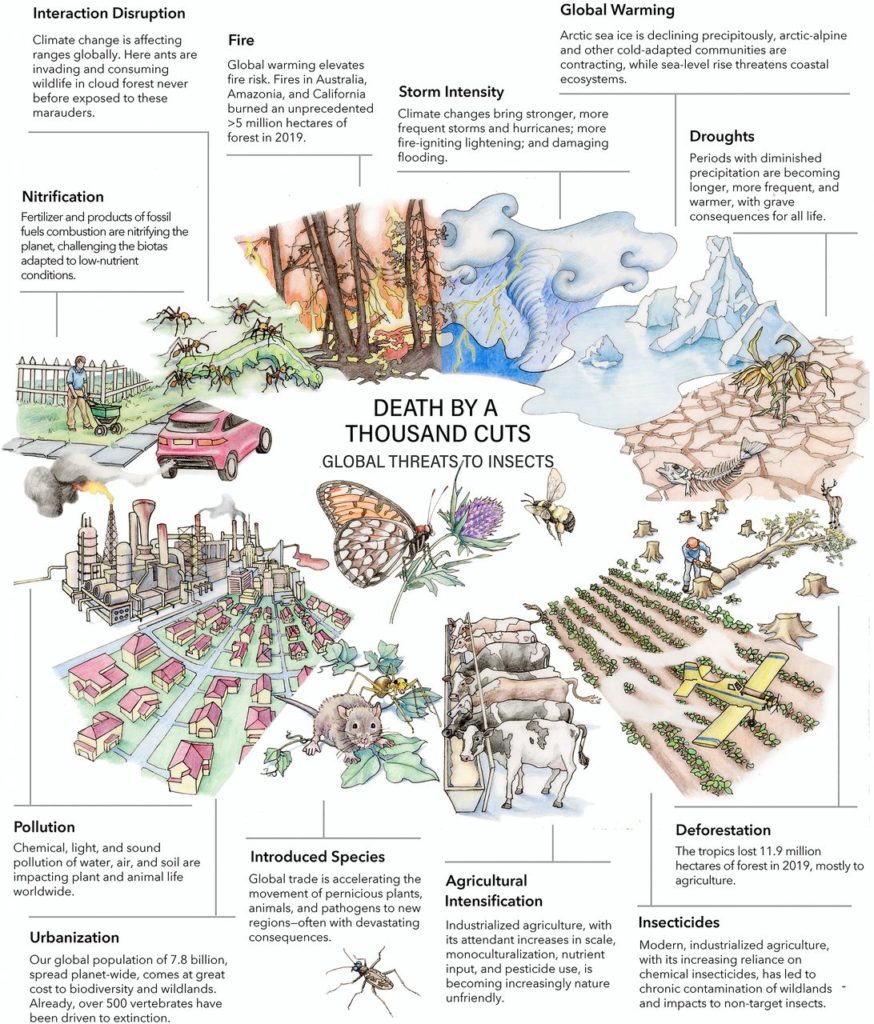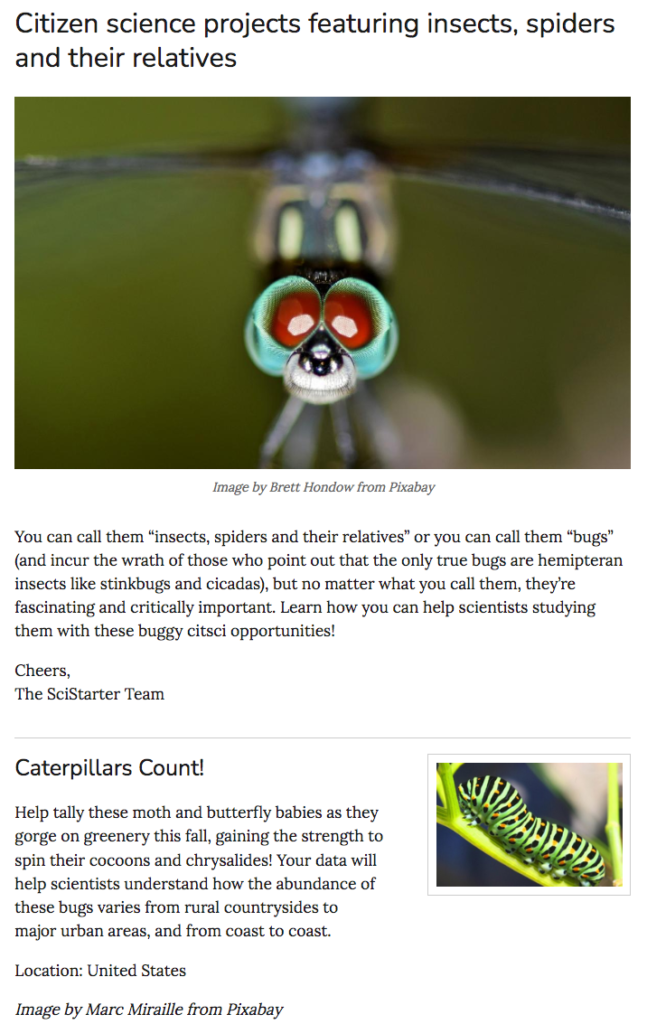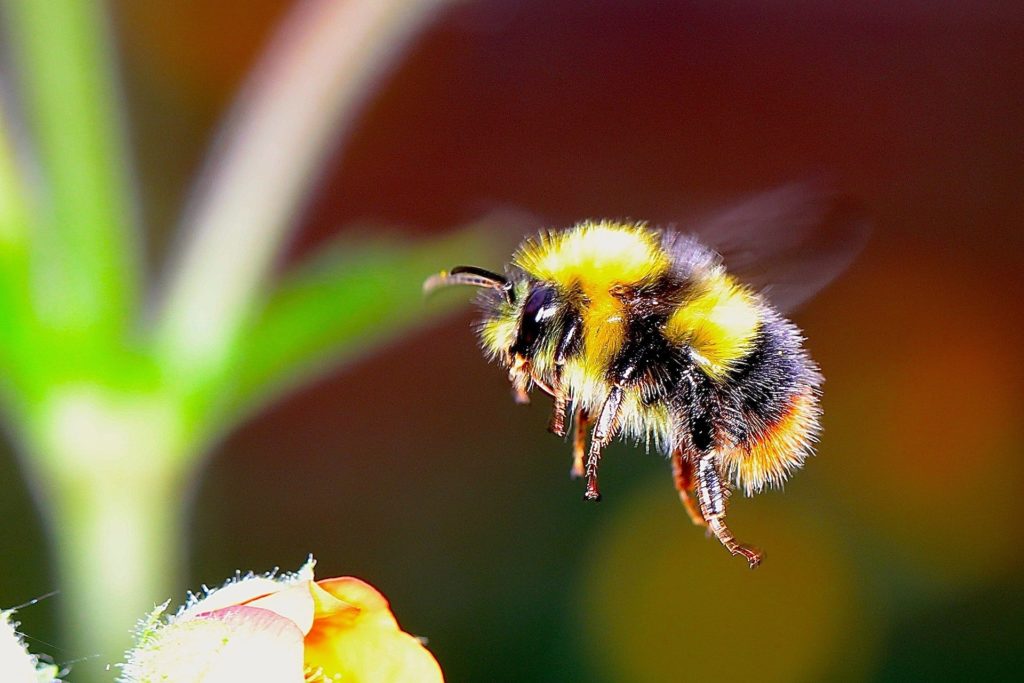Insect populations are declining worldwide, and insect species are becoming extinct at an unprecedented rate. Before you say “Yay!” and perform your (unique and impressive) end zone dance, you should know that insects that plague humans– like mosquitoes, cockroaches, bedbugs, and fleas– are doing quite well, thanks to the warming planet; our willingness to transport these bugs to all the best human feeding grounds on the globe; and the fact that we’re living closer together than ever before, in dense, easy-to-infest environments.

But the overwhelming majority of insect species don’t plague humans; we plague them, by destroying habitats, spraying pesticides, and polluting air and water, along with engaging in other bug-killing activities (figure 1).
And it’s these other insects– the ones we rely on to pollinate our crops, feed our songbirds, support critical ecosystems and keep the planet livable– that are in trouble. The Proceedings of the National Academy of Sciences (PNAS) published a special report– The Global Decline of Insects in the Anthropocene– with 11 papers authored by 56 scientists. Not content to merely report on these declines, the scientists presented a blueprint titled Eight simple actions that individuals can take to save insects from global declines. Ready to save bugs? Then follow these steps:
1. Convert lawns into diverse natural habitats.
Kill your grass? Encourage weeds to flourish? Isn’t this what got Gomez and Morticia Addams in trouble with their homeowners’ association? Well, yes. But lawns are virtual deserts for insects, providing no nectar, pollen or even edible foliage. The PNAS researchers point out that there are more than 40 million acres of these lawn deserts in the U.S. alone, and converting even 10% of them into insect habitat would make a huge difference.
Can it be done without alienating your neighbors? Well, it depends on your neighbors, but according to insect champion and de-lawning warrior Sam Droege, you’ll increase your odds by keeping the edges of your bug sanctuary neatly trimmed, with well-defined paths, and by grouping your native plants in attractive ways, rather than letting them run wild. He says the key is making sure that at the very least, your property doesn’t suggest that the owner has died inside.
2. Grow native plants.
Your local insects are adapted to living with local plants– in fact, they have evolved relationships that go back millions of years, and many butterflies and bees can survive only in partnership with a single species of plant. Do you really want to break up partners that were quite literally made for each other?
3. Reduce pesticide and herbicide use.
Most chemicals that kill bad bugs and plants also kill the good guys, so it’s best to just quit these chemicals altogether. Like kicking any addiction, it might not be easy. But if you select plants that are happy in your region, and well-suited to your soil and light conditions, they shouldn’t need chemical protection.
Artificial lights are bad news for nocturnal bugs and other animals. Imagine you’re a firefly, flashing your relatively tiny butt, looking for love. You don’t stand a chance against that Las Vegas light display.
4. Limit use of exterior lighting.
Lighting up your house like a theme park looks really cool, making even a modest home look like a mini-mansion. But artificial lights are bad news for nocturnal bugs and other animals. Imagine that you’re a firefly, flashing your relatively tiny butt, looking for love. You don’t stand a chance against that Las Vegas light display.
Or imagine you’re a moth, programmed to orient yourself to the brightest light in the sky (usually the moon), furiously trying to adjust to these crazy bright local “moons” until you drop dead from exhaustion.
If you don’t want to eliminate nighttime lighting completely, consider limiting it, both in wattage, orientation (focusing it just where it’s needed), and duration (by adding motion sensors and/or timers, to turn them off before bedtime).
5. Lessen soap runoff from washing vehicles and building exteriors, and reduce use of driveway sealants and de-icing salts.
While washing and waxing your car is a rewarding experience, the detergent you use will likely run off into your local watershed and scrub the delicate gills of tiny water creatures until they’re sparkling-clean and inoperable, killing them, and disappointing the larger fish that had planned to eat them. Getting your car washed at a car wash that manages its runoff could help prevent this. Finding eco-friendly solutions for your outdoor scrubbing, driveway sealing and ice-melting needs would also help.
6. Counter negative perceptions of insects.
Bug friends don’t talk smack about their insect pals behind their backs, nor tolerate those who do. Insects can’t speak up for themselves (lucky for us; can you imagine?) so it’s up to us to support them when we can.
7. Become an educator, ambassador, and advocate for insect conservation.
Knowing what you now know about how cool and important bugs are, you are probably bursting to share your knowledge with the billions of people out there still wallowing in bug ignorance. Go do it!
8. Get involved in local politics, support science, and vote.
Tragically, even 17-year cicadas die before they reach voting age. So it’s up to us to represent insects in the voting booth. That means advocating for bug-friendly laws and neighborhood rules, and, most importantly, habitat protections.
Want to know more? You can read the full report here.
If the citizen science activities described sound interesting, you can find them all, and many more, at SciStarter, an online resource for citizen science activities on a variety of topics. You can also get informative and witty newsletters like the one below delivered directly to your inbox.



 Are Avocado Pits Edible?
Are Avocado Pits Edible?